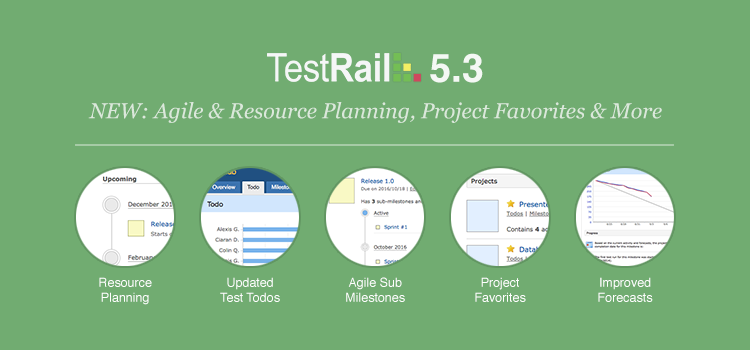We are constantly working on new versions and improvements for TestRail, our modern test management tool, and we are happy to announce the release of TestRail 5.3 today! The new version adds various new agile test management features, better resource planning, improved forecasts and project favorites. Especially if you are managing larger and more complex projects with many releases, testing sprints and iterations, the new version will make it easier for your team to track and organize your tests and to make sure that everyone is focused on the next upcoming release.
TestRail has always been the favorite tool of many agile software testing teams for its fast and productive interface, great integration features with issue and project management tools as well the support for agile testing methods such as exploratory testing and session-based test management. With TestRail 5.3 we are adding more unique features for agile and traditional software teams to make it easier to plan their tests and track the project progress.
Besides many other improvements, the new version introduces sub milestones in TestRail to make it easier to track iterations, sprints and testing phases in addition to releases. We are also adding the capability to track the start and end dates for milestones and releases, added progress warnings if your team is not on track to meet project deadlines, we improved the forecast & progress reports and we updated the to-do lists to enable easier workload distribution. TestRail 5.3 also comes with new features to manage project favorites so users can better focus on their main projects from the dashboard pages. See below for detailed descriptions of the new features and learn how to start using the new version!
Scheduling Milestones & Runs
With TestRail 5.3 we are introducing new features to make it easier to plan and track active, upcoming and completed milestones and related resources. You have always been able to set due dates for your milestones in TestRail so you can plan and control your testing progress easily. With the new version we are also adding options to plan the future start date of milestones (and thus related test runs), provide options to mark milestones as started and redesigned the Milestone tab to visualize your milestone roadmap.
Not only does this make it easier for your team to keep an eye on upcoming milestones and planned start dates, it also helps your team plan future test assignments, resources and upcoming test activities as you can already plan future test runs and assign tests separately from active releases. With the recorded start and due dates of the project milestones, TestRail also includes new warnings on Progress pages if your team is likely not able to meet the goal based on the current progress. Additionally, to make it easier to report on your test runs, new filter options for various built-in reports allow you to select test runs based on the completion date now.

Schedule upcoming releases & milestones and plan resources
Sub Milestones for Iterations, Sprints & Builds
TestRail’s rich project structure already makes it easy to manage projects, releases and iterations or sprints via milestones, test plans and test runs. Especially test plans are a great way to structure, group and start test runs and to test your projects against different platforms such as operating systems, web browsers, mobile devices or other hardware platforms and configurations. For now, most teams used test plans to manage their sprints, iterations and other testing phases that are part of a release in TestRail. With TestRail 5.3 we are introducing sub milestones to add another level to group and manage your test runs.
The new sub milestones allow you to add another layer of milestones from the Milestones tab. We specifically added this to make it easier to manage sub releases, iterations, agile sprints and other milestones of your projects. When you assign test runs to a sub milestone, the statistics of the parent milestone include and show the combined result of all your releases, iterations and sprints tracked as part of the milestone. The new sub milestone feature makes it much easier to plan and keep track of more complex roadmaps and milestone hierarchies in TestRail, and we also updated various filters and pages in TestRail to take advantage of the new milestone hierarchy.
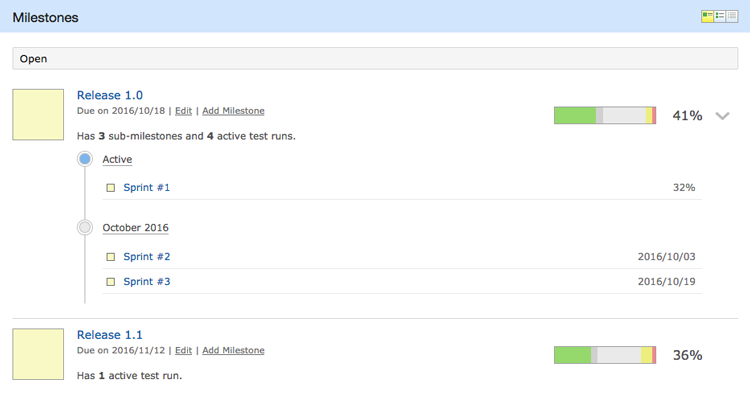
Introducing sub milestones to manage sprints, iterations and sub releases
Updated To-Do Page for Resource Planning
Assigning tests to users is a great way to distribute tasks across the team so that everyone knows exactly what they should be working on. TestRail makes it easy to assign entire test runs, specific configurations or individual sections and tests to different team members. TestRail’s advanced reports with our workload summary report also makes it very easy to track the workload across the team so it’s easy to re-balance assigned tests depending on the testers’ progress.
A central piece of TestRail’s workflow and starting point for most testers is TestRail’s Todo page. TestRail’s Todo page combines multiple use cases and features in a central place: it makes it easy to track and filter progress and assigned tests for team leads, it makes it easy to change assignments between users to adjust the workload and it’s the best way for individual testers to see all their assigned tests for a project. For TestRail 5.3 we’ve improved the Todo page to color mark the assigned test chart for active, upcoming and completion-pending test runs so it’s easier to see the different types of tests grouped by release planning. We also improved the Todo page’s filters by adding new milestone filter options.
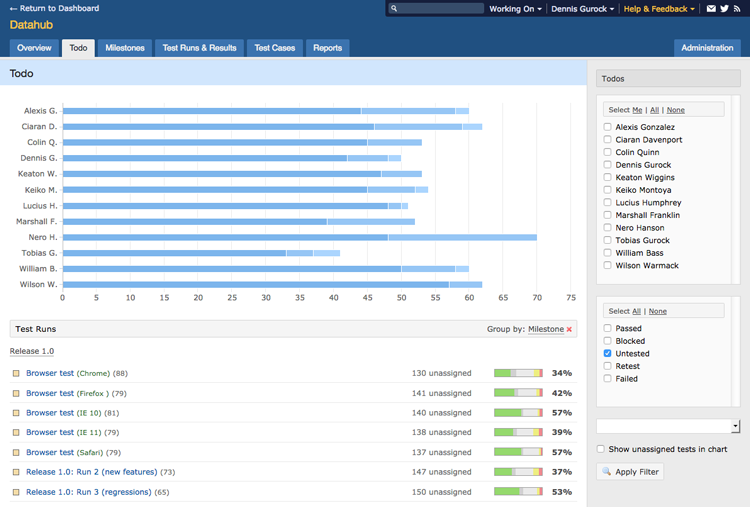
Updated Todo page to highlight active, upcoming and completion-pending tests
Project User Favorites
TestRail’s strong project management features already make it more efficient to work with a large number of projects and with huge teams with 1,000s of testers. You can already easily grant access and deny access to projects, make entire projects read-only, hide projects or archive them. This allows you already to configure which team members should be able to see and access specific projects, and you can easily assign access and permissions on a per user and project basis. Users also have the option to view the project list in different view modes to make it easier to work with a larger number of projects.
With TestRail 5.3 we are introducing a new useful way for users to keep track of projects and to focus on the main projects a user is interested in: project favorites. With project favorites users can easily mark (star) their main projects so they are highlighted in a separate list at the top of the project overview dashboard. This not only makes it easier and faster for users to access their favorite projects, it also gives more options to individual users to organize their dashboard page based on their current tasks.

Helping testers keep track of important projects with project favorites
Additional Improvements
TestRail 5.3 also comes with various additional new features, improvements and productivity enhancements. We’ve listed some of the additional enhancements below and please see our full changelog for a complete list of changes.
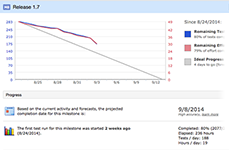
Improved Forecast Calculation
With TestRail’s new resource planning features, we’ve also updated the forecast calculations for the Progress reports to take the new milestone start dates into account. TestRail also falls back to the first test results for more accurate forecasts.

Updated API Methods
We also constantly review and update TestRail’s API for additional API capabilities and useful attributes in the result sets. For TestRail 5.3 we’ve updated the API to return more attributes for the test plan methods among other improvements.
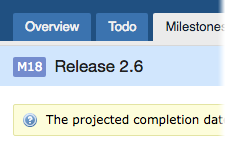
Project Progress Warnings
TestRail’s unique Progress reports and forecasts always helped teams track and compare their testing efforts. TestRail 5.3 now also compares the forecast with the milestone targets and issues a warning if they don’t match.
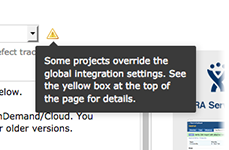
Easier Integration Troubleshooting
Most teams integrate and use TestRail together with an issue and bug tracking tool such as JIRA, Redmine, FogBugz etc. With TestRail 5.3 we’ve added new warning messages to make it easier to troubleshoot project-level integration settings.
Using & Upgrading to TestRail 5.3
Upgrading to TestRail 5.3 is easy and we recommend upgrading to benefit from the new resource planning and agile management features such as sub milestones. We’ve included all the required details below to get TestRail 5.3 up and running, depending on the edition you use:
- TestRail Cloud: your account has already been updated!
- TestRail Server (licensed): you can download the latest version or renew your support plan from your customer portal account.
- TestRail Server (trial): please contact us to upgrade your download trial.
- New user: want to try TestRail? Get a free trial.
You can also review the full change log to learn more about all new features, improvements and bug fixes included in TestRail 5.3. If you have any questions or feedback about the new version, please let us know!
